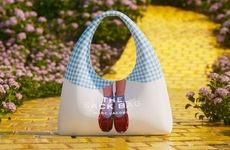
Heleo and Daniel Ruanova Design the Exchange Pavilion
Amy Duong — September 21, 2024 — Art & Design
Local design firm Heleo works together with Tijuana artist Daniel Ruanova on the Exchange Pavilion located in San Diego. It is defined by its twisted wall structures and this means to represent the American-Mexican border as a place to gather. The design is a part of the larger World Design Capital activations that honor art and design in both locations, making this the first time that the NGO has selected joint cities for the designation.
Co-founder of Heleo, Carlos E Hernandez shares that the studio wanted to use 'democratic materials' in the construction process. He states, "It was a very simple gesture, taking these two walls that are bent together, and the corrugation on the material comes from the border wall that exists now, which is corrugated metal. And when you look at it with the polycarbonate, it gives you this kind of low-tech stained glass effect."
Image Credit: Paco Alvarez
Co-founder of Heleo, Carlos E Hernandez shares that the studio wanted to use 'democratic materials' in the construction process. He states, "It was a very simple gesture, taking these two walls that are bent together, and the corrugation on the material comes from the border wall that exists now, which is corrugated metal. And when you look at it with the polycarbonate, it gives you this kind of low-tech stained glass effect."
Image Credit: Paco Alvarez
Trend Themes
1. Democratic-materials Construction - Utilizes accessible and affordable materials like corrugated metal and polycarbonate to create socially impactful architecture.
2. Border-themed Architecture - Incorporates design elements and structures that symbolize sociopolitical boundaries and foster community engagement.
3. Low-tech Aesthetics - Embraces simple, cost-effective materials to achieve visually striking designs reminiscent of traditional stained glass.
Industry Implications
1. Sustainable Architecture - Focuses on innovative usage of readily available materials to meet ecological and economic constraints without sacrificing aesthetic value.
2. Art-driven Urban Development - Blends art and design in urban spaces to create culturally significant and interactive public areas.
3. Cross-border Collaborations - Promotes international partnerships in design and architecture to tackle shared themes and issues across regions.
5.5
Score
Popularity
Activity
Freshness























